Arak Issue 3: Welcome the Iron Maiden!
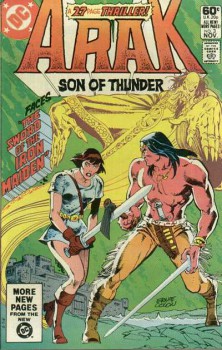
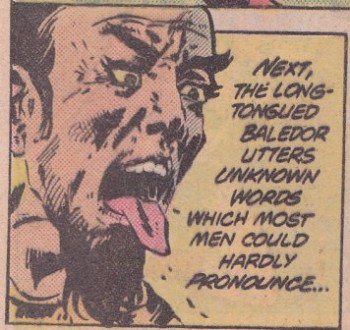 Our adventures with Arak the Viking-Native-American continue!
Our adventures with Arak the Viking-Native-American continue!
Before I summarize issue 3, I haven’t said anything much about the artwork yet, so I’ll do my best to opine on that a bit. I don’t have a particularly deep background in visual art, other than that I’ve been looking at it all my life (and occasionally drawing a cartoon or illustration here and there), so I speak strictly as a layperson on this. That said, here are my general impressions.
First, the elephant in the room: To younger eyes that grew up on the computer-enhanced visuals of the past decade or so, these old pre-‘90s comics must look terribly quaint. Take a representative comic off the stand today. The colors and depth and lighting effects, the impression of characters leaping right out of the 2-dimensional bounds of the page from explosions that look like they could burn your fingers: such is to be seen in any typical issue of a mainstream comic like X-Factor (which is produced twice monthly!)
So, right off the bat, a typical early ‘80s comic like Arak appears, by comparison, pretty flat, the colors dim and washed-out, with a limited palette of hues and rather pedestrian panel lay-out with few or no “effects.” Older comics look much like their ancestral progenitor: the old newspaper comic-strip or “funnies” pages, because that is essentially what they were, printed with the same technology on the same type of thin pulp paper.
Artist Ernie Colón handles the art competently; his anatomy and facial features are particularly commendable, and overall composition is often good, if fairly conservative. He gets some striking poses out of his lead characters, and in story-telling terms, he conveys the action pretty well, moving it along clearly from frozen moment to frozen moment. In short, he is a good, dependable old-school comic-book artist. Just for kicks, compare the earliest work of the renowned Todd McFarlane on titles like The Hulk, when young McFarlane did none of those things particularly well.
Where McFarlane and others distinguished themselves in the ‘90s was by honing in on the striking image, the splash page, the shot composed for maximum impact. Their art became all about the visual effect, whereas with artists like Colon it is definitely more workmanlike service to the story, keeping it moving along, not bringing it to a halt as the reader marvels at a bursting two-page spread. I’m not passing judgment on either style here (okay, except to say that the ‘90s trend that gave birth to Image Comics — and what an apt name for that company — swung to the unfortunate extreme of downplaying story altogether, much like many Hollywood big-budget special-effects movies).
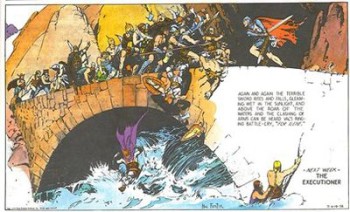
So the art here is of that earlier milieu, with a style that provides a lot of detail but that might be described as “sketchy.” It brings to mind the art of Prince Valiant, although less static than that, being infused with the bang-pow-action style that artists like Jack Kirby brought to comics in an even earlier era.
Colon, I’d say, belongs primarily to the Joe Kubert school of art (although I don’t know if he actually attended the Joe Kubert School of Art), with a style comparable to artists like John and Sal Buscema. This rough, sketchy style seems to have been the preferred one for any fantasy or jungle comics, and I have no complaints.
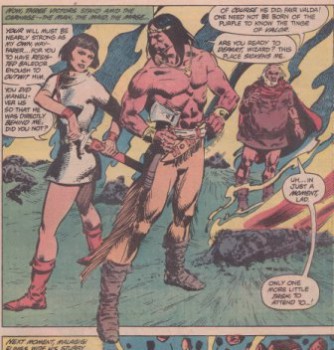 Where the art may sometimes be muddied a bit is with inking that occasionally becomes too busy and splotchy, with the effect of flattening out rather than making things pop, and, of course, the limited palette of color at that time. Backgrounds, for instance, are often just a solid yellow, blue, or purple. Again, quirky touches like this — the artifacts of the time and the technology — can be part of what brings back the nostalgia of first reading and marveling at these stories thirty years ago as a wide-eyed boy. To a kid that age in 2013, I guess it can be like looking at Q-Bert or Space Invaders, shrugging with a “That’s nice, Gramps,” and going back to his Playstation 3 or her Nintendo Wii. But it’s all part of the charm for an old geezer like me, I suppose. Like comparing Harryhausen stop-motion effects to modern CGI — it looks pretty fake, but you can see more of the human hand at work in it.
Where the art may sometimes be muddied a bit is with inking that occasionally becomes too busy and splotchy, with the effect of flattening out rather than making things pop, and, of course, the limited palette of color at that time. Backgrounds, for instance, are often just a solid yellow, blue, or purple. Again, quirky touches like this — the artifacts of the time and the technology — can be part of what brings back the nostalgia of first reading and marveling at these stories thirty years ago as a wide-eyed boy. To a kid that age in 2013, I guess it can be like looking at Q-Bert or Space Invaders, shrugging with a “That’s nice, Gramps,” and going back to his Playstation 3 or her Nintendo Wii. But it’s all part of the charm for an old geezer like me, I suppose. Like comparing Harryhausen stop-motion effects to modern CGI — it looks pretty fake, but you can see more of the human hand at work in it.
Having dedicated so much space to a discussion of the art, I’ll keep my summary brief this week. Issue 3 is a good, solid continuation of the saga. I must confess I am forming the impression that this is pretty decent sword-and-sorcery. Thomas’s choice to root his S&S in this quasi-historical setting is paying off, with the resonance and familiarity provided by familiar peoples and places serving to ground the magic and the monsters.
This issue, in structure, is almost a duplicate of the previous one: a stand-alone face-off with a supernatural being that merely serves to introduce another supporting character on the road to Charlemagne (yes, the court of Carolus Magnus that Arak has been hying toward since issue 1 is the court of none other than Charles the Great, better known as Charlemagne — Thomas even provides an excerpt from Thomas Bulfinch’s Legends of Charlemagne [1862] in the back-page editorial to bring readers up to speed on the historical backdrop to Arak’s current quest).
We open with Arak and his new traveling companion Malagigi (wizard and advisor to the court of Carolus Magnus) beset on the road by brigands. [On a side-note: In this issue, editor Dick (Giordano) begins providing pronunciations in asterisked boxes, as in this one: “* PRONOUNCED MAL-UH-ZHEE-ZHEE — DICK.”]
Arak and the wizard give the brigands the requisite number of warnings — Malagigi informs them of his identity, but, understandably, none of the robbers believe this bedraggled old man wandering the old Roman roads to be the court wizard. Long and short of it, the brigands attack, and, of course, Arak and Malagigi defeat them handily. One wounded brigand is still alive in the aftermath, and herein lies the complicating plot point: this dying man turns out to have been a deserter from the king’s army who came from a nearby humble farm village. His last request to Arak and the wizard is for them to take him back to his village, so he can see his wife and child and die there.
Malagigi is of a mind to let him rot, but Arak shows his sense of honor by agreeing to the man’s dying wish. Arak explains to the mistrustful sorcerer, “If I learned not how to read men while I spent eight winters holed up with Vikings — then I learned nothing worth the knowing.”
In a bit of exposition around the campfire, we get some recap about the sorceress Angelica (from issue 1) along with the revelation that Malagigi has been taking them on a “little, uh, detour” on their trip to the king.
Arak responds, “What? By the dead gods, wizard, if you lead me on a wild-heron chase…!” He is somewhat calmed, though, when he learns that the wizard’s intent is to seek vengeance on the evil sorcerer who made him a captive of Lord Hessa (issue 2). “Ah, why did you not tell me that before?” Arak asks. “Revenge is a motive we of the Quontauka understood well!”
Before Malagigi can have his revenge, though, they must take the wounded brigand Perro back to his family. Perro proves to be a man of his word, but some in his village are not so honorable. As soon as their old clansman arrives with the man claiming to be Malagigi and “that one—with his blood-colored skin”, some of them are plotting to betray them to the evil sorcerer to whom they must pay tribute. That sorcerer is Baledor, the very sorcerer whom Malagigi has a beef with.
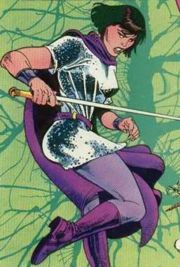 Before Baledor makes his grand entrance, his henchman arrives in the village, a knight on horseback, clad head-to-toe in plate armor. At first, Arak suspects it to be an empty suit, like the magical animatrons of Lord Hessa, but no, this is a foe of flesh and blood. The big surprise for Arak comes when he un-helms her to find that she is a her: “ — But I would see what kind of man would — Eye of Othin! It — was a woman I fought!? Such a thing — is not possible!”
Before Baledor makes his grand entrance, his henchman arrives in the village, a knight on horseback, clad head-to-toe in plate armor. At first, Arak suspects it to be an empty suit, like the magical animatrons of Lord Hessa, but no, this is a foe of flesh and blood. The big surprise for Arak comes when he un-helms her to find that she is a her: “ — But I would see what kind of man would — Eye of Othin! It — was a woman I fought!? Such a thing — is not possible!”
And so we are introduced to Valda, the Iron Maiden. And for her part, she immediately reveals that she is a spitfire with tongue as well as sword: “You’ll care not if it was damsel or demon, varlet, when I turn my spike gauntlets on — “
Anywho, Malagigi steps in and frees her from the enchantment Baledor had put on her, but only just in time for the duplicitous townsmen who throw a giant net over all three, conveniently hauling them — along with poor Perro, who had just been reunited with his family and looked like he was on his way to recovery — to this awful wizard Baledor.
Incidentally, here is a wonderful piece of melodramatic pulp metaphor, a la Thomas, describing the capture of our three heroes in a net:
“And, within moments, the three of them, enmeshed in its folds as they are, are brought down by sheer weight of numbers. So do dogs always bring down the wolf…the fox…the tigress.”
Can you match the animal to its human analogue? Answer key: Wolf=Arak. Fox=Malagigi. Tigress=Valda.
When the captives behold Baledor’s abode, they are awestruck to see it is a huge earth-mound, from which the dread sorcerer arises. He strokes his magical ram’s horn and waves his fingers, immediately causing the captors to disintegrate! He conveniently speaks his motives aloud, in the manner of all comic-book villains: “You took it upon yourself to bring these four to me, did you, vilagers? That shows independence of thought, after a fashion…and that makes you dangerous!”
More disturbingly, he then sticks forth a Gene-Simmons-length tongue and causes Perro’s head to explode.
This really ticks Arak off, who exclaims, “Monster! The men of the Quontauka used to torture their captives — but only after they’d bested them in fair combat.”
 This outburst merely causes Baledor now to turn his attention on his remaining three captives. He casts a spell that puts Arak and Valda under his command. He commands them to fight each other so Malagigi can look on helplessly, knowing that the victor will then be rewarded with the task of beheading him. (And at this point I’m wondering what, exactly, Malagigi expected to accomplish against this dude Baledor? I mean, he can make peoples’ heads explode by wagging his tongue; he has mind control…)
This outburst merely causes Baledor now to turn his attention on his remaining three captives. He casts a spell that puts Arak and Valda under his command. He commands them to fight each other so Malagigi can look on helplessly, knowing that the victor will then be rewarded with the task of beheading him. (And at this point I’m wondering what, exactly, Malagigi expected to accomplish against this dude Baledor? I mean, he can make peoples’ heads explode by wagging his tongue; he has mind control…)
Ready for the twist? Arak cannot overcome Baledor’s command to deliver the killing blow to Valda, but he does have enough of his own wits about him to maneuver himself and time the throw of his otomahuk so that Valda is directly in front of Baledor. He’s seen enough of Valda’s reflexes to know she’ll duck, and when she does, the weapon finds lodging squarely in the wizard’s bald pate.
Even with an axe-blade to the forehead, Baledor’s baleful sorcery keeps him alive, but he is weakened enough that Malagigi can step in and do his thing: “Time for me to stop playing the overfed opossum…and take matters into my own hands, before the rat crawls back into this hole.” He lights Baledor up like a Fourth of July firework.
We then get a fine pose of Arak slipping his otomahuk back into his belt and Valda sheathing her blade as they exchange a wary look full of tension of the you-know-what variety. Indeed, during the dénouement, as they are camping that night, the narrator informs us that “Valda, however, despite her mannish ways, finds herself intrigued by this lithe young warrior so unlike any man she has ever encountered, nobly-born or no…” And we are three-for-three, folks, for issues where a female is “intrigued” by Arak.
A few final thoughts, as we wrap this one up, and these all get high marks from me:
VIOLENCE!
1. Before Arak’s party — which now includes two traveling companions — rides off on their journey, they return to the village to deliver the news to Perro’s family of his demise. When Valda, in trying to offer some solace, informs Perro’s wife that he was avenged, the widow tearfully responds, “Avenged!? Wh-what good will that do for me — or my son?” Valda is so flummoxed that she looks to Arak for assistance. Arak, remembering how he lost his own family in a raid when his whole tribe was wiped out, remains stonily silent. This attention to the ramifications of war and murder and death gives Arak a strong dose of reality. The guy’s head exploding with the utterance of a spell may be over-the-top S&S, but the effect of this man’s death is not overlooked or underplayed. Kudos to Thomas for delivering something of the trauma along with the titillation of the fantasy-violence.
WARRIOR WOMEN!
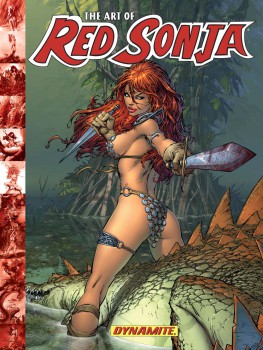 2. Okay, with Valda we have our “chick-in-chainmail,” Red-Sonja type, but she seems more rooted in reality, less in teen fantasy, than others of her ilk. For one thing, this “woman who rides the paths of knighthood” is much more practically attired. She wears a full suit of chain-mail that bares only her forearms and legs. She still cuts a fine figure (I don’t know if chain-mail ever was that form-fitting), but it provides much more realistic protection than the “armor” of any number of other women-warriors, which generally only protects their groins and nipples (the very same areas, incidentally, that also needed protection from Comics-Code censorship).
2. Okay, with Valda we have our “chick-in-chainmail,” Red-Sonja type, but she seems more rooted in reality, less in teen fantasy, than others of her ilk. For one thing, this “woman who rides the paths of knighthood” is much more practically attired. She wears a full suit of chain-mail that bares only her forearms and legs. She still cuts a fine figure (I don’t know if chain-mail ever was that form-fitting), but it provides much more realistic protection than the “armor” of any number of other women-warriors, which generally only protects their groins and nipples (the very same areas, incidentally, that also needed protection from Comics-Code censorship).
MAGIC!
3. Finally — and I saved this for last because I found it particularly intriguing — in this issue Thomas lays out the basics of this world’s magic system. Early in the comic, Malagigi explains to Arak that there are “Four Pillars of Power.” There are “Words of Power,” that is, spells. He also includes “wizardly gestures” in this category, and this type of power can, presumably, be taught. Then there are “Persons of Power,” such as he and the sorceress Angelica. Thirdly, there are “Places of Power,” which are “scattered hither and yon across the world.” Finally, there are “Things of Power,” talismans like the ring that Angelica claimed in issue 1. These can also include “scrolls themselves, or weapons, or even beasts.” These pillars can be combined, i.e. a person of power using words of power at a place of power, perhaps augmented by a thing of power, will be about as powerful as you can get.
As I listened to Malagigi’s little magic lesson, I couldn’t help but think how closely this tracks with the magic system of Advanced Dungeons and Dragons. Indeed, I’d say it’s about a direct match with 3rd edition. Wizards gain their power by learning spells — Words of Power — while sorcerers have their magic innately; they are Persons of Power. Of course, those sources can be augmented in the game by Places and Things of Power — by magic items and the like.
Next issue: “A Woodland Savage in Carolus Magnus’ Court!”
I really look forward to reading these reviews/summaries of yours each week. This is another great job.
On the art, it might be my age and the fact that I grew up on the art of this era and earlier, but I prefer it to much of the more photo-realistic look of comics today. The new stuff looks much flatter to me than Colon’s does. Of course, I could just be looking at the wrong artists. 🙂
Keep up the good work!
Thanks Ilene! This art style was sometimes better showcased in black-and-white, when these artists drew for some of the magazines like Eerie and Savage Sword of Conan.
[…] Arak issue 3: Welcome the Iron Maiden […]